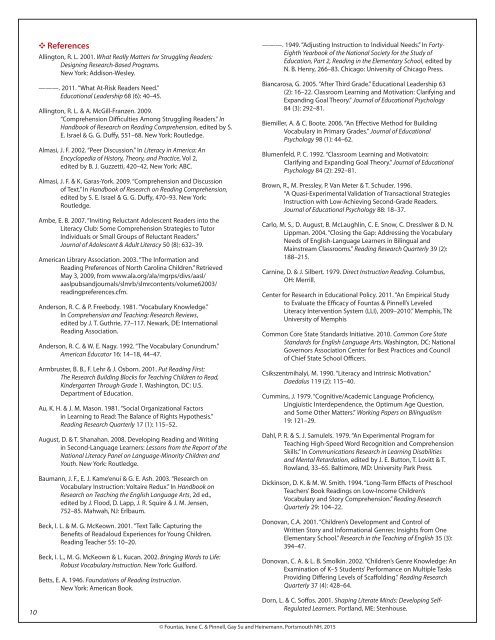Leveled Literacy Intervention
LLI_3_8_ResearchBase
LLI_3_8_ResearchBase
Create successful ePaper yourself
Turn your PDF publications into a flip-book with our unique Google optimized e-Paper software.
10<br />
YYReferences<br />
Allington, R. L. 2001. What Really Matters for Struggling Readers:<br />
Designing Research-Based Programs.<br />
New York: Addison-Wesley.<br />
———. 2011. “What At-Risk Readers Need.”<br />
Educational Leadership 68 (6): 40–45.<br />
Allington, R. L. & A. McGill-Franzen. 2009.<br />
“Comprehension Difficulties Among Struggling Readers.” In<br />
Handbook of Research on Reading Comprehension, edited by S.<br />
E. Israel & G. G. Duffy, 551–68. New York: Routledge.<br />
Almasi, J. F. 2002. “Peer Discussion.” In <strong>Literacy</strong> in America: An<br />
Encyclopedia of History, Theory, and Practice, Vol 2,<br />
edited by B. J. Guzzetti, 420–42. New York: ABC.<br />
Almasi, J. F. & K. Garas-York. 2009. “Comprehension and Discussion<br />
of Text.” In Handbook of Research on Reading Comprehension,<br />
edited by S. E. Israel & G. G. Duffy, 470–93. New York:<br />
Routledge.<br />
Ambe, E. B. 2007. “Inviting Reluctant Adolescent Readers into the<br />
<strong>Literacy</strong> Club: Some Comprehension Strategies to Tutor<br />
Individuals or Small Groups of Reluctant Readers.”<br />
Journal of Adolescent & Adult <strong>Literacy</strong> 50 (8): 632–39.<br />
American Library Association. 2003. “The Information and<br />
Reading Preferences of North Carolina Children.” Retrieved<br />
May 3, 2009, from www.ala.org/ala/mgrps/divs/aasl/<br />
aaslpubsandjournals/slmrb/slmrcontents/volume62003/<br />
readingpreferences.cfm.<br />
Anderson, R. C. & P. Freebody. 1981. “Vocabulary Knowledge.”<br />
In Comprehension and Teaching: Research Reviews,<br />
edited by J. T. Guthrie, 77–117. Newark, DE: International<br />
Reading Association.<br />
Anderson, R. C. & W. E. Nagy. 1992. “The Vocabulary Conundrum.”<br />
American Educator 16: 14–18, 44–47.<br />
Armbruster, B. B., F. Lehr & J. Osborn. 2001. Put Reading First:<br />
The Research Building Blocks for Teaching Children to Read,<br />
Kindergarten Through Grade 1. Washington, DC: U.S.<br />
Department of Education.<br />
Au, K. H. & J. M. Mason. 1981. “Social Organizational Factors<br />
in Learning to Read: The Balance of Rights Hypothesis.”<br />
Reading Research Quarterly 17 (1): 115–52.<br />
August, D. & T. Shanahan. 2008. Developing Reading and Writing<br />
in Second-Language Learners: Lessons from the Report of the<br />
National <strong>Literacy</strong> Panel on Language-Minority Children and<br />
Youth. New York: Routledge.<br />
Baumann, J. F., E. J. Kame’enui & G. E. Ash. 2003. “Research on<br />
Vocabulary Instruction: Voltaire Redux.” In Handbook on<br />
Research on Teaching the English Language Arts, 2d ed.,<br />
edited by J. Flood, D. Lapp, J. R. Squire & J. M. Jensen,<br />
752–85. Mahwah, NJ: Erlbaum.<br />
Beck, I. L. & M. G. McKeown. 2001. “Text Talk: Capturing the<br />
Benefits of Readaloud Experiences for Young Children.<br />
Reading Teacher 55: 10–20.<br />
Beck, I. L., M. G. McKeown & L. Kucan. 2002. Bringing Words to Life:<br />
Robust Vocabulary Instruction. New York: Guilford.<br />
Betts, E. A. 1946. Foundations of Reading Instruction.<br />
New York: American Book.<br />
———. 1949. “Adjusting Instruction to Individual Needs.” In Forty-<br />
Eighth Yearbook of the National Society for the Study of<br />
Education, Part 2, Reading in the Elementary School, edited by<br />
N. B. Henry, 266–83. Chicago: University of Chicago Press.<br />
Biancarosa, G. 2005. “After Third Grade.” Educational Leadership 63<br />
(2): 16–22. Classroom Learning and Motivation: Clarifying and<br />
Expanding Goal Theory.” Journal of Educational Psychology<br />
84 (3): 292–81.<br />
Biemiller, A. & C. Boote. 2006. “An Effective Method for Building<br />
Vocabulary in Primary Grades.” Journal of Educational<br />
Psychology 98 (1): 44–62.<br />
Blumenfeld, P. C. 1992. “Classroom Learning and Motivatoin:<br />
Clarifying and Expanding Goal Theory.” Journal of Educational<br />
Psychology 84 (2): 292–81.<br />
Brown, R., M. Pressley, P. Van Meter & T. Schuder. 1996.<br />
“A Quasi-Experimental Validation of Transactional Strategies<br />
Instruction with Low-Achieving Second-Grade Readers.<br />
Journal of Educational Psychology 88: 18–37.<br />
Carlo, M. S., D. August, B. McLaughlin, C. E. Snow, C. Dresslwer & D. N.<br />
Lippman. 2004. “Closing the Gap: Addressing the Vocabulary<br />
Needs of English-Language Learners in Bilingual and<br />
Mainstream Classrooms.” Reading Research Quarterly 39 (2):<br />
188–215.<br />
Carnine, D. & J. Silbert. 1979. Direct Instruction Reading. Columbus,<br />
OH: Merrill.<br />
Center for Research in Educational Policy. 2011. “An Empirical Study<br />
to Evaluate the Efficacy of Fountas & Pinnell’s <strong>Leveled</strong><br />
<strong>Literacy</strong> <strong>Intervention</strong> System (LLI), 2009–2010.” Memphis, TN:<br />
University of Memphis<br />
Common Core State Standards Initiative. 2010. Common Core State<br />
Standards for English Language Arts. Washington, DC: National<br />
Governors Association Center for Best Practices and Council<br />
of Chief State School Officers.<br />
Csikszentmihalyi, M. 1990. “<strong>Literacy</strong> and Intrinsic Motivation.”<br />
Daedalus 119 (2): 115–40.<br />
Cummins, J. 1979. “Cognitive/Academic Language Proficiency,<br />
Lingjuistic Interdependence, the Optimum Age Question,<br />
and Some Other Matters.” Working Papers on Bilingualism<br />
19: 121–29.<br />
Dahl, P. R. & S. J. Samulels. 1979. “An Experimental Program for<br />
Teaching High-Speed Word Recognition and Comprehension<br />
Skills.” In Communications Research in Learning Disabilities<br />
and Mental Retardation, edited by J. E. Button, T. Lovitt & T.<br />
Rowland, 33–65. Baltimore, MD: University Park Press.<br />
Dickinson, D. K. & M. W. Smith. 1994. “Long-Term Effects of Preschool<br />
Teachers’ Book Readings on Low-Income Children’s<br />
Vocabulary and Story Comprehension.” Reading Research<br />
Quarterly 29: 104–22.<br />
Donovan, C.A. 2001. “Children’s Development and Control of<br />
Written Story and Informational Genres: Insights from One<br />
Elementary School.” Research in the Teaching of English 35 (3):<br />
394–47.<br />
Donovan, C. A. & L. B. Smolkin. 2002. “Children’s Genre Knowledge: An<br />
Examination of K–5 Students’ Performance on Multiple Tasks<br />
Providing Differing Levels of Scaffolding.” Reading Research<br />
Quarterly 37 (4): 428–64.<br />
Dorn, L. & C. Soffos. 2001. Shaping Literate Minds: Developing Self-<br />
Regulated Learners. Portland, ME: Stenhouse.<br />
© Fountas, Irene C. & Pinnell, Gay Su and Heinemann, Portsmouth NH, 2015


